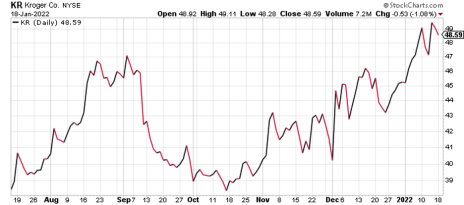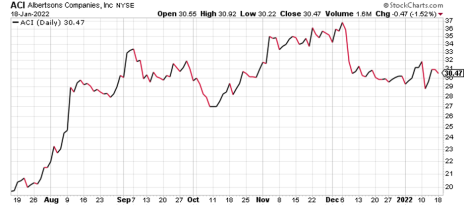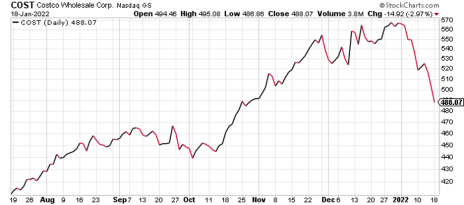Much ink has been spilled on the topic of inflation, and with good reason. More than stock market swings, inflation puts the current economic environment right on the kitchen table. Consumers that wouldn’t normally read financial news are still reading their supermarket receipts and seeing higher prices everywhere they turn.
Inflation is at a 40-year high and food prices have been a big contributor. A gallon of milk costs $3.67, a six-year high. Soybean prices are up 46% in the last year. Corn prices are up 21%. Ground beef is up 17%. And on and on it goes.
In November 2021, U.S. grocery sales reached roughly $70 billion, the second-highest monthly number ever behind March 2020 ($75 billion), the month basically everything except grocery stores shut down. After dipping to as low as $63 billion in October 2020, grocery sales have risen more than 10%, including four straight months. Given that the Omicron variant has forced people to go into their bunkers again in December and January, you can bet grocery sales will only go up when those months get reported.
And so should grocery store stocks. The following three companies are relatively pure plays on the ongoing grocery boom – I didn’t include multi-purpose retailers like Walmart or Target in here, since they don’t just sell food. All three have beaten the market in the last year and should continue to do so in the coming year.
3 Supermarket Stocks Getting a Boost from Food Price Inflation
Supermarket Stock #1: Kroger (KR)
Kroger is the largest grocery chain in the U.S. behind Walmart, with $135 billion in sales in the last 12 months—a 7.2% improvement from the prior 12 months. That may not sound like much, but it would qualify as the company’s highest year-over-year growth total in six years, with the notable exception of 2020 (14.5% growth). And while profits are down from 2020 too, earnings per share have risen for three straight quarters, and are expected to rise again (to 71 cents) in the current quarter.
As for the stock, it’s up 45% in the last year yet still trades at a mere 13 times forward earnings estimates. In fact, it’s just off new all-time highs as of this writing. Throw in a 1.8% dividend yield, and there’s a lot to like about Kroger stock.
Supermarket Stock #2: Albertsons (ACI)
With nearly 2,300 stores, Albertsons has the second-largest footprint of any supermarket chain in the U.S., behind Kroger. Based in Boise, Idaho, Albertsons has raked in $69 billion in sales in the last 12 months, up 4.7% from the prior period. While top-line growth is expected to slow this year (to a mere 0.40%), the stock is both dirt cheap and accelerating: ACI shares trade at just 12 times forward earnings despite being up a whopping 70% in the last year. Having just bounced off support at 29, this looks like a prime buying opportunity.
Supermarket Stock #3: Costco (COST)
Costco is a bit of a different animal – a wholesaler that requires a membership. But it sells groceries for cheap, and that keeps customers coming back; it’s the sixth-largest retailer in the world, according to the National Retail Federation (NRF). Though much bigger than the two aforementioned companies, it’s nonetheless growing faster these days; sales are up 16% in the last 12 months, with 13% earnings growth. Don’t expect much of a drop-off this year: analysts anticipate 11% sales growth and 15% EPS growth in 2022.
As for the stock, it’s up 38% in the last year, though it’s not the bargain stock the other two are, trading at a forward P/E of 42. With COST shares in the midst of a pretty significant correction, you’ll be better served waiting for the stock to establish a bottom before diving in.
Bottom Line
By the Fed’s own admission, inflation is no longer considered “transitory;” it’s here to stay, at least for a while longer. So you should expect food prices to remain high for most of the year. That might make for some eye-popping numbers every time your local grocery clerk rings you up. But you combat those high costs by investing in the very companies that are gouging you.
Do you own any grocery stocks not listed here? Tell us about them in the comments below!




